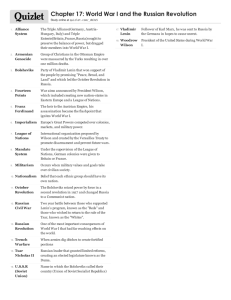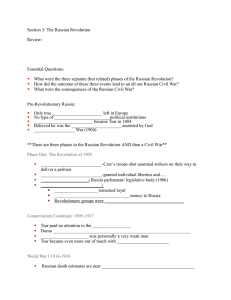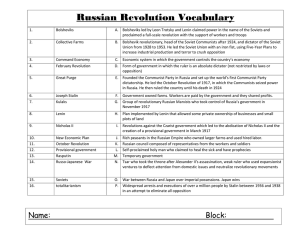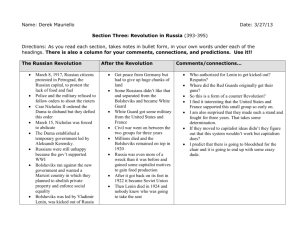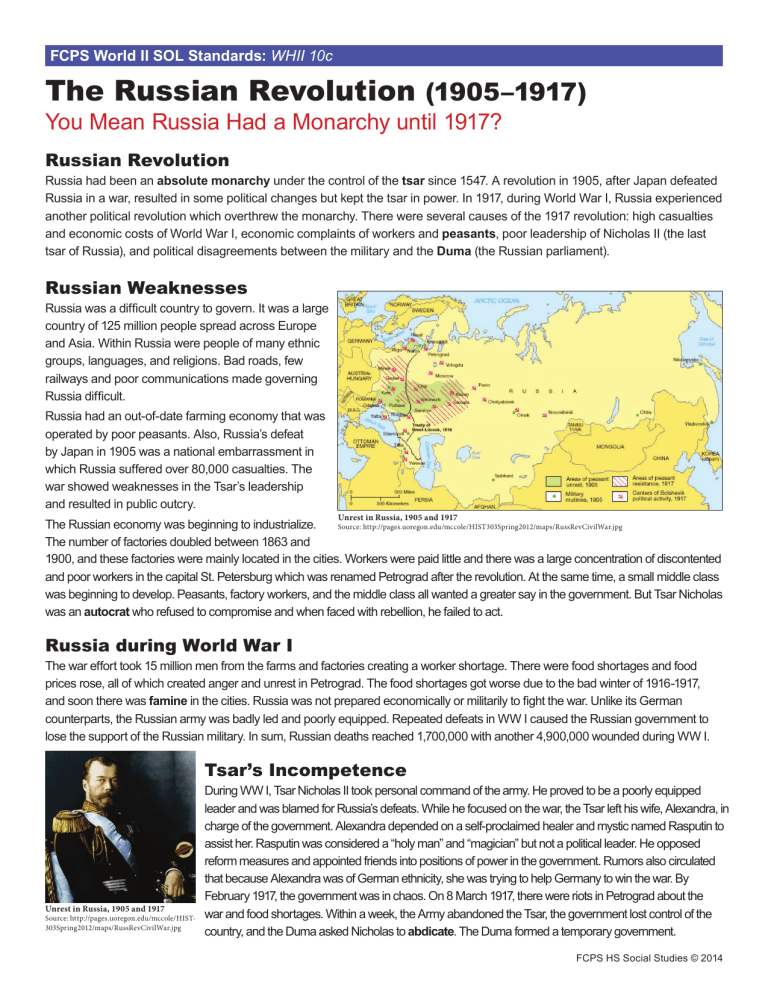
FCPS World II SOL Standards: WHII 10c The Russian Revolution (1905–1917) You Mean Russia Had a Monarchy until 1917? Russian Revolution Russia had been an absolute monarchy under the control of the tsar since 1547. A revolution in 1905, after Japan defeated Russia in a war, resulted in some political changes but kept the tsar in power. In 1917, during World War I, Russia experienced another political revolution which overthrew the monarchy. There were several causes of the 1917 revolution: high casualties and economic costs of World War I, economic complaints of workers and peasants, poor leadership of Nicholas II (the last tsar of Russia), and political disagreements between the military and the Duma (the Russian parliament). Russian Weaknesses Russia was a difficult country to govern. It was a large country of 125 million people spread across Europe and Asia. Within Russia were people of many ethnic groups, languages, and religions. Bad roads, few railways and poor communications made governing Russia difficult. Russia had an out-of-date farming economy that was operated by poor peasants. Also, Russia’s defeat by Japan in 1905 was a national embarrassment in which Russia suffered over 80,000 casualties. The war showed weaknesses in the Tsar’s leadership and resulted in public outcry. Unrest in Russia, 1905 and 1917 The Russian economy was beginning to industrialize. Source: http://pages.uoregon.edu/mccole/HIST303Spring2012/maps/RussRevCivilWar.jpg The number of factories doubled between 1863 and 1900, and these factories were mainly located in the cities. Workers were paid little and there was a large concentration of discontented and poor workers in the capital St. Petersburg which was renamed Petrograd after the revolution. At the same time, a small middle class was beginning to develop. Peasants, factory workers, and the middle class all wanted a greater say in the government. But Tsar Nicholas was an autocrat who refused to compromise and when faced with rebellion, he failed to act. Russia during World War I The war effort took 15 million men from the farms and factories creating a worker shortage. There were food shortages and food prices rose, all of which created anger and unrest in Petrograd. The food shortages got worse due to the bad winter of 1916-1917, and soon there was famine in the cities. Russia was not prepared economically or militarily to fight the war. Unlike its German counterparts, the Russian army was badly led and poorly equipped. Repeated defeats in WW I caused the Russian government to lose the support of the Russian military. In sum, Russian deaths reached 1,700,000 with another 4,900,000 wounded during WW I. Tsar’s Incompetence Unrest in Russia, 1905 and 1917 Source: http://pages.uoregon.edu/mccole/HIST303Spring2012/maps/RussRevCivilWar.jpg During WW I, Tsar Nicholas II took personal command of the army. He proved to be a poorly equipped leader and was blamed for Russia’s defeats. While he focused on the war, the Tsar left his wife, Alexandra, in charge of the government. Alexandra depended on a self-proclaimed healer and mystic named Rasputin to assist her. Rasputin was considered a “holy man” and “magician” but not a political leader. He opposed reform measures and appointed friends into positions of power in the government. Rumors also circulated that because Alexandra was of German ethnicity, she was trying to help Germany to win the war. By February 1917, the government was in chaos. On 8 March 1917, there were riots in Petrograd about the war and food shortages. Within a week, the Army abandoned the Tsar, the government lost control of the country, and the Duma asked Nicholas to abdicate. The Duma formed a temporary government. FCPS HS Social Studies © 2014 Russian Revolution (cont.) WHII 10c Bolshevik Revolution World War I had destroyed the Russian economy. Vladimir Lenin, a Russian revolutionary who had fled Russia, returned in 1917 and organized factory workers to seize the government. These workers were part of the Bolsheviks (which means “majority” in Russian), and their actions were called the Bolshevik Revolution. For the next three years (1918-1920), 14 million Russians died in a civil war and the following economic crisis. Among those killed were Tsar Nicholas and his family. Lenin and the Bolsheviks defeated their rivals and formed the world’s first government based on communism. Communism was an idea proposed by German philosopher Karl Marx who believed a class-less and equal society would exist after workers and peasants Lenin and the Bolsheviks Source: http://upload.wikimedia.org/wikipedia/commons/6/63/ seized power. Lenin ordered that all farmland be distributed among the peasants and Lenin-Trotsky_1920-05-20_Sverdlov_Square_(original).jpg gave control of factories to committees set up by the workers. Lenin’s efforts to repair the Russian economy were called the New Economic Policy (NEP). Under the NEP, peasants were able to sell their crops, but the government kept control of major industries such as banks and communications. Lenin organized the country into 15 republics (what we might call states) that were controlled by a central government. The name of the country was changed from Russia to the Union of Soviet Socialist Republics (U.S.S.R.), sometimes shortened to the Soviet Union. Key Vocabulary Communism: a type of government in which all classes are equal and all share equally in wealth and power Peasants: a poor farmer of low social status Tsar: the title of the Russian monarch, sometimes spelled czar Absolute monarchy: a type of government in which a king or queen who has unlimited power Duma: legislative body in the ruling assembly of Russia Abdicate: to give up the throne and power Autocrat: a ruler who has absolute power Famine: severe lack of food Quick Review 1. Which of the following was a reason for the start of the Russian Revolution? A. Famine and poverty B. Peace with Japan C. Increased trade D. Strong economy 3. What term best names the ideology in the box? A. Democracy B. Capitalism C. Militarism D. Communism 2. What title best fits the diagram? A. Lenin’s actions B. Stalin’s actions C. Tsar’s actions D. Duma’s actions 4. List and explain two to three reasons for the Russian Revolution of 1917. Connection to Today Resources What revolutions are taking place in the world today? What are the major issues? Who is involved? What are the actions and outcomes? ABC-CLIO ● The Russian Revolution 1905 http://worldhistory.abc-clio.com/Search/Display/309920?terms=russi an+revolution ● The Russian Revolution 1917 http://worldhistory.abc-clio.com/Search/Display/309927?terms=russi an+revolution FCPS HS Social Studies © 2014


